How to get the most from air-driven handpieces with the TwinPower Ultra Series
The dental practitioner requires handpieces that are effective and comfortable for use all day, every day. They must be ergonomic in the dentist’s hand and practical in tooth preparation, particularly in patients with limited opening (both children and adults) and for endodontic access.
The dental practitioner requires handpieces that are effective and comfortable for use all day, every day.
They must be ergonomic in the dentist’s hand and practical in tooth preparation, particularly in patients with limited opening (both children and adults) and for endodontic access.
The highspeed dental handpiece has been the dentist’s principal preparation instrument since first introduced in the early 1960s. This technology has extended the practitioner’s ability to efficiently prepare teeth in far less time, extending the benefits of dental treatment to a larger segment of the population.
Together, highspeed tooth preparation and dental anesthesia have increased the physical and emotional acceptance of dental procedures to a large segment of the population, contributing to the extended maintenance of the natural dentition over the patient’s entire lifetime.
Handpiece requirements
Throughout the process of tooth preparation, the dentist’s primary objectives are uninterrupted cutting, moving the bur effectively, at a constant speed, through all natural or restorative materials regardless of their hardness (continuous speed under load).
The critical factors are torque, power and speed. The bur’s cutting power is dependent on consistent, balanced torque at any bur rotational speed.
Using air-driven handpieces
The power of air-driven handpieces, particularly those with smaller heads, has been problematic until recently. Traditional highspeed rotors have eight impeller blades driven by one drive air nozzle. As the blades rotate through their cycle, they are not always positioned at the optimal angle to capture all of the forced air from the nozzle, weakening torque.

The TwinPower Ultra Series turbine rotor from J. Morita USA has a double-impeller design that features 36 impeller blades powered by three drive air nozzles. Much like a series of sails, multiple blades offer more surface area to capture more drive air. As the blade angles rotate, some are always optimally positioned to be impelled by one of the three nozzles.

The balanced double-impeller assembly is powerful (up to 22W), generating a constant torque and superior cutting power while virtually eliminating vibration. The advanced fluid dynamics engineering also reduces the high-pitched (6-7 kHz) whine generated by highspeed handpieces, quieting treatment for both patients and the dental team.
RELATED: 5 ways your handpiece is holding you back
The tight confines of the mouth present a limited access to the dental practitioner. For children and patients with TMJ limitations, the use of traditional handpieces can be rather uncomfortable, making the dentist’s task even more difficult.
A standard sized head may contact opposing teeth, creating a stressful and uncomfortable sensation. The J. Morita TwinPower Turbine Ultra Series (UltraM and UltraE) offers a compact head design that provides excellent and reliable cutting ability with smooth, vibration-free operation. The bur can be held upright during molar preparation with the mirror placed at an angle to the handpiece head, minimizing water and debris accumulation.
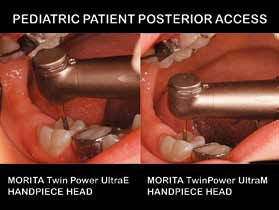
The TwinPower UltraM head offers better access on the occlusal and buccal surfaces in the posterior region, making dental procedures far more comfortable for patients. These “mini” handpieces are twice as strong as others in the category, powerful enough for everyday tooth preparation.
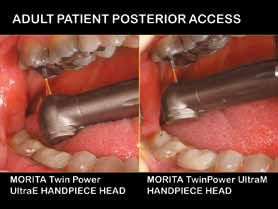
The small head size of the TwinPower Ultra handpieces offers outstanding posterior access and excellent mirror and microscope viewability. This feature is extremely important when preparing endodontic access. A standard handpiece head must be slanted to provide occlusal visibility.
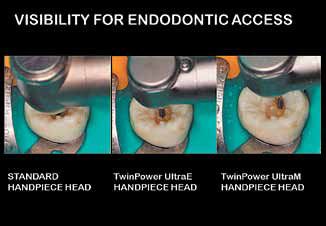
As a result, the angulation of the bur removes more tooth structure than necessary. The shape of the TwinPower UltraE head allows it to be positioned vertically into the access preparation, preserving precious tooth structure.
It also provides an enhanced direct or microscope view of the access area; the small head permits improved mirror positioning and better vision.
Comfort, access critical
Because the handpiece is used for up to 20 minutes in every operative hour, it must be very comfortable in the practitioner’s hands. The compact TwinPower weighs as little as 48 grams, minimizing hand, wrist, and finger fatigue over extended use.
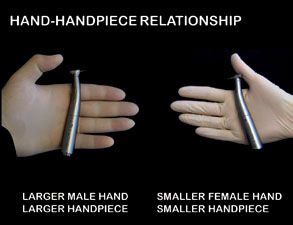
The weighting of the handpiece balances the functional load to reduce repetitive stresses on the hands. Its ergonomically developed grip encourages a relaxed grasp of the handpiece while the proprietary ceramic coating treatment increases friction, improving tactile control and durability throughout multiple sterilization cycles.
The handpiece angulation determines the ease with which it can be maneuvered around the various areas of the oral cavity. The TwinPower’s standard handpiece has a 15° head angulation that aligns the bur shaft with the tooth’s axis, facilitating preparation. Its 21.5° visual access slope permits greater visibility of the operative area.
The problem of “suck back” was first recognized in the early 1990s. It was demonstrated that air driven highspeed handpieces were potentially at risk for transferring microbes from one patient to the next. The mechanism was initiated when the air flow was interrupted to brake the rotation of the bur; as the turbine stopped, there was a small volume inside the handpiece head that was negatively pressurized, theoretically able to “suck back” saliva, blood and other oral fluids into the handpiece channels.
When the handpiece was next activated, these contained fluids would be expelled into another patient’s mouth! For this reason, extensive and comprehensive sterilization (usually steam autoclave) was made mandatory for highspeed handpieces.
The J. Morita TwinPower Series handpieces solve this problem through an ingenious fluid dynamics innovation.
The drive air flows into the Anti Suck Back Diffuser (ASBD) within the head of the handpiece where it is pressurized by impeller rotation centrifugal force.
When the rheostat brakes the handpiece, centrifugally forced air continues to flow into the ASBD, maintaining its pressurization. The pressurized air in the Diffuser releases at the bottom of the head, through the same vent to which the exhaust air is directed. Thus, the pressurized air in the ASBD prevents depressurization in the handpiece head, producing a truly zero “suck back” and facilitating infection control.
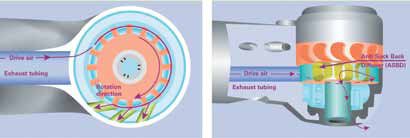
It is essential that the bur stop rotating immediately when the operator’s foot is removed from the rheostat. This can be problematic for ball bearing highspeed handpieces. The implications can be serious; even a short inadvertent “run-on” can cause significant damage to hard and soft tissues. This concern is magnified with children who tend to move their heads unexpectedly and unpredictably.
The distinctive TwinPower rubber brake ring brings the entire handpiece to a rapid stop when the drive air is interrupted, offering a safer, and more secure environment for tooth preparation.
RELATED: How to save time and money while caring for your handpieces [VIDEO]
Increasingly, many proactive intervention and minimally invasive procedures are accomplished without the need for local anesthetic. Caries are identified earlier and treated more conservatively.
Most handpieces dispense the drive air that has impelled the blades directly on to the preparation site. This vertical stream of cold air can generate discomfort that necessitates injected anesthetic. The TwinPower Series employs a pioneering radial air bypass that disperses this unwanted air sideways, minimizing patient discomfort and allowing the unaesthetized procedure to continue until completion.
These handpieces are built around ceramic ball bearings that are significantly lighter than their conventional metal counterparts. They are also much harder (up to 3X), providing a much longer turbine lifecycle, and feature a smooth operation that reduces tooth preparation noise and vibration.
Illumination is an important part of tooth preparation, and today, few dentists rely solely on the overhead light.
Handpiece lighting of the operative field is a clinical must. The LED Coupler for the TwinPower Turbine uses the most advanced LED technologies to enhance visibility and make dental operations faster and more efficient. The LED light offers a bright, naturally colored, repeatable, and even illumination that lessens eye fatigue and facilitates the identification of caries and soft tissue diseases.
Conclusion
The TwinPower Series represents a major advance on several fronts of handpiece technology. The double impeller guarantees high power performance.
The various compact and ergonomically-designed heads facilitate posterior and paedodontic treatment. The fluid dynamics reduce the noise and the ball bearings eliminate the vibration. Most important enhancements, however, are the in-hand comfort for the practitioner, and the zero “suck back” that prevents inter-patient bacterial transmission.
TwinPower Turbine Basic features

- Double-impeller rotor design produces high power and torque
- Pressurized air system prevents suction back
- Ceramic bearings, push-button chuck and a lightweight chrome body
J. Morita USA
jmoritausa.com | 800-831-3222
ACTIVA BioACTIVE Bulk Flow Marks Pulpdent’s First Major Product Release in 4 Years
December 12th 2024Next-generation bulk-fill dental restorative raises the standard of care for bulk-fill procedures by providing natural remineralization support, while also overcoming current bulk-fill limitations.